Search results for: Mckinsey 7s
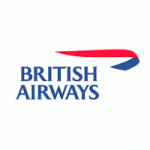
British Airways segmentation, targeting and positioning refer to ways in which the airline company identifies certain individuals among the general public to offer their service packages. Segmentation involves dividing population into groups according to certain characteristics, whereas targeting implies choosing specific groups identified as a result of segmentation to sell products. Positioning refers to the selection of the marketing mix the most suitable for the target customer segment. British Airways follows multi-segment concentration marketing strategy by offering four different service packages to different customer segments. Specifically, British Airways targets different customer segments for its four levels of services: economy, premium economy, executive and first class. The following table illustrates segmentation, targeting and positioning of each category of British Airways services: Segmentation bases Target segment Economy class Premium Economy Executive Club First Class Geographic Region Domestic flights in UK Europe and international flights Selected international flights Europe and international flights Selected international flights Density Urban & rural Urban & rural Urban Urban Demographic Age Kids, teenagers, middle-aged, old-aged Teenagers, middle-aged Middle-aged, old-aged Middle-aged, old-aged Gender Male, female Income Low Middle High High Occupation Students, salaried Students, salaried Businessmen Professionals Businessmen Professionals Education High school Bachelor’s Technical Bachelor’s Master’s Business schools Master’s Business schools Social status Low, middle Low, middle High High Family size Joint families Nuclear families Nuclear families Newly married Psychographic Lifestyle Moderate-orientated Moderate-orientated Achievement-oriented Achievement-oriented Personality Easygoing Easygoing Determined Ambitious Behavioural Occasions Regular travel Vacations Business trips Honeymoon Business trips Benefits sought Affordability Value Luxury Convenience Luxury User status Regular traveller Regular traveller First timer, Regular traveller First timer, Regular traveller Attitude Indifferent Indifferent positive Positive enthusiastic Enthusiastic Travel and tourism industry base Customer expectations Low Medium High High Customer image Neutral Neutral to positive Positive…
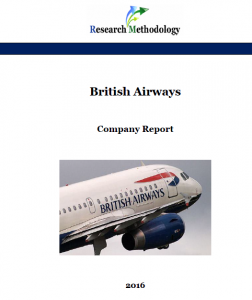
British Airways (BA) is the largest airline company in the UK and it flies globally to more than 400 destinations to airports in nearly 80 countries. British Airways is a part of International Airline Group (IAG) that also owns three other airline brands – Aer Lingus, Iberia and Vueling. The Group also owns 13.55 per cent of the equity of IB OpCo Holding S.L. (“Iberia”) and 86.26 per cent of the equity of Avios Group (AGL) Limited (“AGL”). IAG made a record profit of GBP 1,264 million in 2015. By the end of 2015, British Airways had 39,304 employees globally (Annual Report, 2015). British Airways pursues service differentiation business strategy and differentiates its services via an extensive reliance on digitalization and information technology and high level of customization of service provision. These points represent solid sources of British Airways’ competitive advantage. Major weaknesses related to British Airways include an overdependence on the UK market and low profitability of business operations. At the same time, the airline is presented with the opportunities of forming strategic cooperation with other businesses in airline and catering industries, further engaging in international market expansion and benefiting from synergy via closer integration between IAG’s operating airlines. British Airways Report contains the application of the major analytical strategic frameworks in business studies such as SWOT, PESTEL, Porter’s Five Forces, Value Chain analysis and McKinsey 7S Model on British Airways. Moreover, the report contains analyses of British Airways’ business strategy, leadership and organizational structure and its marketing strategy. The report also discusses the issues of corporate social responsibility. 1. Introduction 2. Business Strategy 3. Leadership 4. Organizational Structure 5. SWOT Analysis 5.1 Strengths 5.2 Weaknesses 5.3 Opportunities 5.4 Threats 6. PESTEL Analysis 6.1 Political Factors 6.2 Economic Factors 6.3 Social Factors 6.4 Technological Factors 6.5 Environmental Factors 6.6…
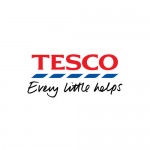
Tesco CSR programs and initiatives are developed and implemented by Corporate Responsibility Committee led by Chairman John Allan. The importance of CSR for Tesco maybe greater nowadays than ever before due to a series of ethics-related scandals the supermarket chain had to deal with recently such as inappropriate profit reporting and poor supplier treatment cases. In other words, it is important for the supermarket chain to restore the trust of its towards the brand and engagement in CSR programs and initiatives is an effective tool to achieve this objective. The company releases Corporate Responsibility Update regularly and it includes the details of CSR programs and initiatives engaged by the company. The table below illustrates the highlights from the latest report for the financial year of 2014/15: Categories of CSR activities Tesco Performance Supporting local communities The company donated GBP 55 million, which accounts to 3.96 per cent of its pre-tax profit to various charities and good causesIn total, GBP 37.9 million has been raised from Tesco employees and via customer fundraising Educating and empowering workers 70% of employees stated they would recommend Tesco as a great place to workAs much as 77 per cent of managers, directors and business leaders within the company made career progresses Labor and human rights The supermarket chain declares its commitment to UN Universal Declaration of Human Rights and the International Labour Organization Core ConventionsIn 2010, Tesco’s USA stores, Fresh & Easy was accused by Human Rights Watch for allegedly exploiting weak labour laws in the US and bullying employees to prevent them from joining unions[1] Employee health and safety In 2015 a total of 1539 employees in retail and distribution were injured at work that resulted in fractures or lost time of more than three days Gender equality and minorities The percentage gap in payment…
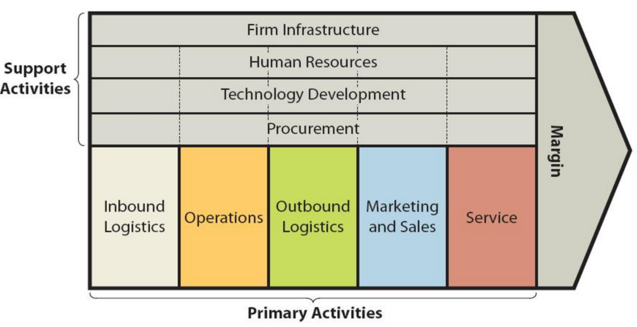
Value chain analysis is an analytical framework that assists in identifying business activities that can create value and competitive advantage to the business. The figure below illustrates the essence of value chain analysis. Tesco value chain analysis Primary Activities Inbound logistics Tesco inbound logistics operations are complex and involve the supply of hundreds of product categories to 7817 Tesco stores around the world[1]. Economies of scale due to the large scope of its operations is a major source of value creation for Tesco. The company makes regular investments to increase the capacity of logistics so that the economies of scales can be exploited to a greater extent. For example, in 2013 as a part of a government-backed trial program testing the efficacy of longer trailers, Tesco received 25 new 51-foot Gray & Adams refrigerated units. New trailers can carry 51 cages (UK shipping units), six more than a standard 45-foot trailer. This change resulted in 13 per cent increase in logistics productivity[2]. The company has a history of poor supplier treatment under the previous leadership that involved the cases of payment delays to improve Tesco’s operational profit margins[3] and unnecessary and unjustified fines being imposed to suppliers[4] with negative implications on various aspects of supply chain practices. However, the new management led by new CEO Dave Lewis announced its commitment to form strategic relationships with suppliers. Operations Tesco operations can be divided into three large segments: 1. Retail. This segment represents the core business of Tesco PLC. With more than 80 million shopping trips made thousands of Tesco shops in 11 countries around the world[5], the scope of Tesco’s retail operations is extensive. The company operates stores in the following format: Metro. Metro stores sell wide range of food and a smaller selection of general items such as cook ware…
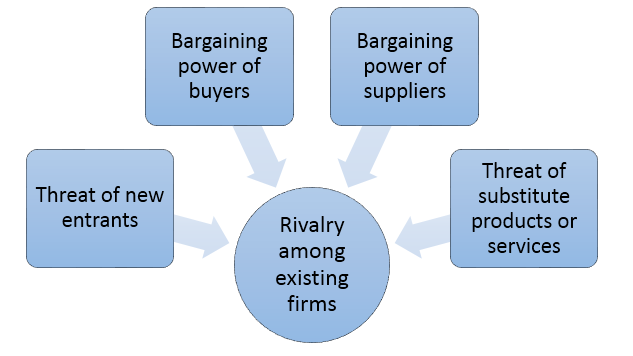
Tesco Porter’s five forces attempts to analyze five separate forces that determine the extent of overall competition in the grocery retail industry. These forces are represented in Figure 1 below: Figure 1 Tesco Porter’s Five Forces Threat of substitute products or services for Tesco is irrelevant. Tesco sells a wide range of products belonging to the following categories: Clothing & jewelry Technology & gaming Health & beauty Home electrical Entertainment & books Home appliances Baby & toddler Garden Toys DIY & Car The range of products sold by Tesco is highly comprehensive. The supermarket chain sells a wide range of products, as well as, substitutes of the majority of these products. Therefore, it can be argued that the threat of substitute products and services for Tesco is irrelevant. Rivalry among existing firms in supermarket chain sector is fierce. The amount of advertising expenditure and the extent of differentiation of products and services are major factors impacting the competitiveness of companies operating in food and grocery retail industry. There are no switching costs for consumers and this fact also increases the intensity of competition in the industry. As it is illustrated in Figure 2 below, although there are many major market players in the grocery retail industry in the UK, Tesco maintains a clear leadership position despite challenges the company currently faces. Figure 2 Market share of grocery retail chains in the UK from January 2015 to April 2016[1] Bargaining power of Tesco suppliers is low. Tesco has hundreds of suppliers and there is a minimum or no supplier switching cost for the supermarket chain. The company has the history of using its barraging power to delay payment to suppliers in order to improve its operational profit margins under the previous leadership in 2014.[2] After this and other incidents of poor…
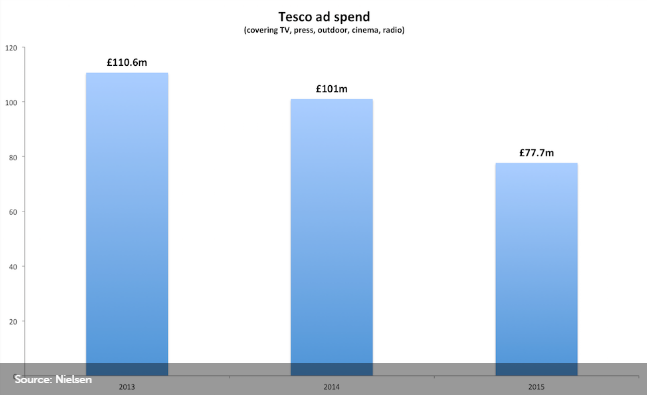
Currently, Tesco marketing strategy aims to regain the trust of stakeholders to the brand. The company is refocusing on “Every Little Helps” strapline to strengthen its core traditional competitive advantage in the marketplace. Certain elements of the marketing communication mix such as print and media advertising, sales promotions, events and experiences and public relations are used by the retail chain to communicate this message to customers. Advertising Tesco marketing strategy makes an extensive use of print and media advertising systematically as a tested channel to send marketing communicate message to current and potential consumers. It is important to note that although Tesco has decreased its advertising budget in 2015 compared to previous years as a part of its massive cost-saving initiatives (see figure below), the efficiency of its print and media advertising has increased. This has been achieved via application of marketing differentiation. For example, during Christmas period, the retail chain eschewed an emotional campaign for humour using the family of characters, played by Ruth Jones and Ben Miller, it had introduced earlier in the year.[1] Changes in Tesco advertising budget Occasionally, Tesco print and media advertising contains valuable advises on cooking or home styling. For example, company recently “released reactive print ads around the Great British Bake Off, with a “bake it or fake it” theme. One page shows what ingredients someone can buy to make the creations shown on TV, the other page shows what they can buy instead.”[2] Sales Promotion Various forms of sales promotions play an integral role within Tesco marketing strategy. The supermarket chain facilitates sales promotions in the following formats: Clubcard. Customers collect 1 point for each GBP 1 spent in Tesco. Several times a year customers receive statements and and vouchers equal to the value of points they have saved. Free gifts. The supermarket chain offers free…
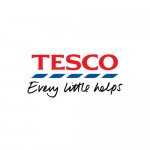
PESTEL is a strategic analytical tool used to evaluate external environment for the business. Specifically, Tesco PESTEL analysis involves an evaluation of political, economic, social, technological, environmental and legal factors affecting the retail chain. Political Factors A range of political factors can affect Tesco in direct and indirect ways. The list of political factors that may affect Tesco include but not limited to political stability in the UK and abroad, bureaucracy and the extent of corruption in Tesco’s home market in international markets. Moreover, activities of trade unions and home market lobbying initiatives in international markets are important political factors that affect the retail chain. Tesco’s new Chairman, John Allan has proved himself as an outspoken business leader to express his views about impacts of political factors on the business. For example he has stated that “the prospect of an EU referendum is causing uncertainty for investors, and this represents a “heavy pebble” placed in the scales of the British economy”[1]. Certain political factors can potentially have negative implications on Tesco’s bottom line. For example, in 2014 a group of local councils in the UK formally asked the government to for new powers to tax large supermarkets, an initiative that became known as ‘Tesco Tax’.[2] Although, this specific initiative was refused by the UK government to avoid price increases, similar political initiatives may succeed in the future with negative implications for Tesco. Economic Factors Various macroeconomic factors affect Tesco to a great extent. The cost of labor is one of the major economic factors greatly impacting the revenues of the supermarket chain. The company’s annual wage bill accounts to GBP 4.5 billion. Accordingly, increase of 1 per cent in the cost of labor costs the company about GBP 45 million. An increase of the national minimum wage to GBP 7.20…

Tesco Board of Directors comprises 10 members and there were significant changes in the Board during the financial year 2014/15. These changes include the appointment of John Allan as the Chairman of the Board, the appointment of a new CEO Dave Lewis and new Chief Financial Officer Alan Steward, the retirement of four Non-Executive Directors and the appointment of three new Non-Executive Directors. In 2015, Mr. Lewis announced the reduction of costs across head office functions by 30 per cent with direct implications on the management structure. As it is illustrated in Figure 1 below, Tesco governance structure comprises five committees reporting to Tesco PLC board. There are 11 members in Tesco Executive Committee led by Group Chief Executive Dave Lewis. Figure 1 Tesco Corporate Governance Structure Tesco organizational structure is highly hierarchical reflecting the large size of the business. Even in store level, there are as many as four layers of management in some large stores. The Figure 2 below illustrates a typical organizational structure within Metro, Superstore and Extra formats. It is important to note that the structure below is not rigid for all Tesco stores and some stores operate with a slightly different structure reflecting their location, size and a range of other store-specific factors. Figure 2 Tesco organizational structure at store level It can be argued that three or four management layers within a single store may create unnecessary bureaucracy with a negative implications on the flow of information across the management layers. Therefore, the senior level management needs to consider delayering opportunities i.e. increasing the flexibility of operations and changes within store and accelerating the flow of information via reducing the layers of management. Tesco PLC Report comprises a comprehensive analysis of Tesco. The report illustrates the application of the major analytical strategic frameworks in…
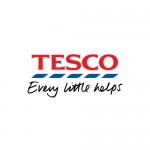
Tesco leadership had to change following a major scandal in 2015 that involved the cases of supplier mistreatment and profit mis-declarations as revealed by BBC’s Panorama.[1] John Allan has been elected as a new Chairman of the Board and Dave Lewis, who once was a supplier for Tesco has been appointed as the new CEO to lead a new senior management team. Restoration of trust of stakeholders in general and consumers and suppliers in particular has been announced as the main strategic task by the new management. The new leadership has introduced a new Code of Business Conduct, supported17 by a company-wide training programme along with other measures in order to prevent wrongdoings in the future. Simplification of the business has emerged as another main priority for the new management team. Range of initiative declared by Tesco leadership also include concentrating on “availability, service and selectively on price; undertaking a significant programme of restructuring and financial discipline; and launching a programme of renewal to restore trust in every aspect of the brand”[2] The new management aims to address supplier relationship issues proactively and it has established new Supplier Helpline, designed to resolve payment and administrative issues quickly and simply.[3] The first ‘outsider’ to lead Tesco since its foundation in 1919, Dave Lewis has been able successful so far as a CEO with his drastic measures that included “selling Blinkbox entertainment arm; slashing up to 10,000 positions and shutting stores; closing down Cheshunt and putting its GBP1bn Clubcard data business Dunnhumby and its South Korean arm up for sale. A new deal is reportedly on the table with staff to end its costly defined-benefit pension scheme, worth GBP3bn.”[4] Tesco PLC Report constitutes a comprehensive analysis of Tesco business strategy. The report illustrates the application of the major analytical strategic frameworks in business…
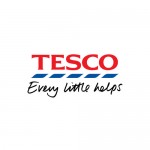
Tesco business strategy can be described as cost leadership and its motto ‘Every Little Helps’ guides its business strategy to a considerable extent. Economies of scale is one of the main competitive advantage extensively exploited by Tesco due to the vast scale of its operations. Tesco business strategy has traditionally involved experimentation with various aspects of the business and this strategy changed the overall retail industry in the UK to a certain extent. For example, Tesco was the first retailer to introduce 24-hour shopping experience and today it has thousands of Click & Collect points across the country.[1] Tesco business strategy for the short-term is aimed at regaining stakeholder trust in general and customer trust in particular following commercial income reporting scandal in 2015. The senior level management has announced that this objective will be achieved via the following set of initiatives: Focusing on availability, service and selectively on price Undertaking a significant programme of restructuring and financial discipline Launching a programme of renewal to restore trust in every aspect of the brand Moreover, as an outcome of income reporting scandal combined with a set of other factors, Tesco is currently in a difficult financial position with a total leverage debt of GBP 22 billion and the net debt of GBP 8.5 billion.[2] The following initiatives have been introduced by the senior level management in order to reduce the volume of debt: Not paying final dividends to shareholders for the financial year 2014/15 Reducing the amount of capital expenditure to GBP 1 billion Replacing defined benefit pension scheme for all employees Reviewing Tesco’s property portfolio, including leases that amount to GBP 1.5 billion annual rent bill The sale or closure of all three Blinkbox businesses (movies, music and books) and Tesco Broadband Tesco PLC Report contains more detailed discussion of…
